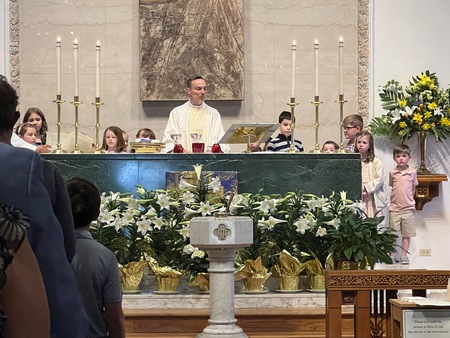Several years ago during an overnight event at the church I served, my high school youth ministry filed into our sanctuary and participated in a prayer ritual around the altar that involved lit candles. Unbeknownst to me, the wax from the candles destroyed the altar’s covering.
When the ruined covering was discovered, there was hell to pay.
People questioned, “Why would you let teenagers light candles on the altar?”
I’d respond by explaining, “Because we light candles on the altar every Sunday in worship and I was trying to create an environment where our teenagers could connect with God in a powerful way.”
What I learned that week was that young people’s encounters with God were less important than protecting the altar space in the sanctuary.
Sadly, I’ve seen this play out in other ways as well.
In many faith communities, only the pastor is allowed to stand behind the altar.
That’s why it’s been so striking to me that at our new church, each week at the start of communion, the pastor invites children to come forward and to stand with him behind the altar. The result is a holy cacophony the likes of which I’ve never seen before.
Every week, children race down the aisle towards the altar as Father George stands there, patiently waiting for them to arrive before he begins the communion liturgy, knowing that they’ll see and experience communion differently from behind the altar than they would from anywhere else in the sanctuary.
Since the practice began months ago, it’s continued to evolve. When clergy realized the smallest children couldn’t see over the altar (despite being up front), they ordered stools for them to stand on to make the space more inviting to them.
Some weeks, young people bring whatever they’ve brought to church forward with them… which means that occasionally, Barbie and stuffed animals also come to the altar.
Now, when Father George talks about “the gifts of God for the people of God,” he hands off the communion elements to children to hold high above their heads, further integrating them into the practice of communion.
The practice is messy and chaotic, and some weeks, I legitimately worry that a child (or more specifically, my child) will drop the wine carafe.
And one day, that may very well happen but here’s the thing: Even if they did, this practice would still be worth it. Through it, children are engaging in worship; they’re encountering God; and they’re coming to a table God has already invited them to. What’s more, the grown ups are also learning that when we say all our welcome at God’s table, we really mean all.
I’ve fallen in love with this practice and am thrilled each week when my daughters, Hope (7) and Kendall (3), race forward to join the mayhem.
That said, I fully expected this beloved practice to disappear on Easter. After all, Easter is the Sunday when the church is full; when we have to be at our best, most excellent selves in order to welcome visitors. Amidst a crazy day, packed sanctuaries, and carefully orchestrated worship timelines, who’s got time for kids to get situated behind the altar before beginning the communion liturgy?
Apparently, Father George.
When communion rolled around, like usual, Father George invited the children forward and off they went, this time in their Sunday best (which is not always how they’re dressed, mine included.)

As they moved forward, all I could think about is the Scripture passage that says that at Jesus’ death, the temple curtain ripped in two, from top to bottom. Many people understand this to mean that the Holy of Holies - the area of the temple that only priests could enter at select times of the year - was now open to all.
On Easter, as I watched Hope and Kendall stand at the altar with Father George, that’s what I saw: a visible reminder that even the most sacred places are meant for ALL people; that neither an altar nor its covering is more important than people.
As I’ve sat with this image over the last 24 hours, I’ve found myself remembering those questions about the ruined altar covering from years ago: “Why would you let teenagers light candles on the altar?”
What I couldn’t articulate then, but I could now is that I let teenagers light candles on the altar because it’s theirs.
That most sacred part of the sanctuary is theirs just as much as it’s mine or yours or the pastor’s.
The curtain is gone. The veil has been ripped.
And everyone is welcome at the table.